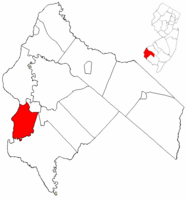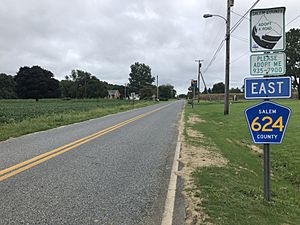Elsinboro Township, New Jersey facts for kids
Quick facts for kids
Elsinboro Township, New Jersey
|
|
|---|---|
|
Township
|
|

|
|

Elsinboro Township highlighted in Salem County. Inset map: Salem County highlighted in the State of New Jersey.
|
|

Census Bureau map of Elsinboro Township, New Jersey
|
|
| Country | |
| State | |
| County | |
| Earliest mention | May 12, 1701 |
| Incorporated | February 21, 1798 |
| Named for | Fort Nya Elfsborg |
| Government | |
| • Type | Township |
| • Body | Township Committee |
| Area | |
| • Total | 13.34 sq mi (34.56 km2) |
| • Land | 11.93 sq mi (30.90 km2) |
| • Water | 1.41 sq mi (3.66 km2) 10.58% |
| Area rank | 182nd of 565 in state 11th of 15 in county |
| Elevation | 10 ft (3 m) |
| Population
(2020)
|
|
| • Total | 1,001 |
| • Estimate
(2023)
|
1,006 |
| • Rank | 532nd of 565 in state 15th of 15 in county |
| • Density | 83.9/sq mi (32.4/km2) |
| • Density rank | 546th of 565 in state 13th of 15 in county |
| Time zone | UTC−05:00 (Eastern (EST)) |
| • Summer (DST) | UTC−04:00 (Eastern (EDT)) |
| ZIP Code |
08079 – Salem
|
| Area code(s) | 856 |
| FIPS code | 3403321330 |
| GNIS feature ID | 0882064 |
| Website | |
Elsinboro Township is a small community in Salem County, New Jersey. It is a type of local government called a township. In 2020, about 1,001 people lived there.
Elsinboro was first mentioned in records way back on May 12, 1701. It officially became one of New Jersey's first townships on February 21, 1798. The township got its name from an old fort called Fort Nya Elfsborg.
Contents
History of Elsinboro Township
Early European Settlements
In the 1600s, when Europeans first arrived, the Delaware River was known as the South River. The Salem River was called Varkens Kill, or Hogg Creek. In 1641, a group of 60 settlers from the New Haven Colony bought land. This land was along the kill (a small stream or river) from the native Lenape people.
Fort Nya Elfsborg
In 1643, Johan Björnsson Printz arrived as the governor of New Sweden. He ordered the building of Fort Nya Elfsborg. This fort was named after a fortress in Sweden. It was located on the Delaware River, between the Salem River and Alloway Creek.
Later, in 1655, the Dutch took control of the area. Then, in 1664, the British captured it.
Geography of Elsinboro Township
Location and Size
Elsinboro Township covers about 13.34 square miles (34.56 square kilometers). Most of this area is land, about 11.93 square miles (30.90 square kilometers). The rest is water, about 1.41 square miles (3.66 square kilometers).
Rivers and Features
The Salem River forms part of the township's northern border. Alloway Creek runs along its southern border. The site of the old Fort Nya Elfsborg is also found here. Money Island is a small area in the southwest part of the township.
Neighboring Areas
Elsinboro Township shares borders with a few other places. These include Lower Alloways Creek Township, Pennsville Township, and Salem. It also borders the Delaware Bay.
Local Communities
Within Elsinboro Township, you can find several smaller communities. These include Elsinboro Neck, Elsinboro Point, Hagerville, and Oakwood Beach.
Population of Elsinboro Township
| Historical population | |||
|---|---|---|---|
| Census | Pop. | %± | |
| 1810 | 517 | — | |
| 1820 | 505 | −2.3% | |
| 1830 | 503 | −0.4% | |
| 1840 | 526 | 4.6% | |
| 1850 | 655 | 24.5% | |
| 1860 | 749 | 14.4% | |
| 1870 | 700 | −6.5% | |
| 1880 | 570 | −18.6% | |
| 1890 | 524 | −8.1% | |
| 1900 | 445 | −15.1% | |
| 1910 | 419 | −5.8% | |
| 1920 | 374 | −10.7% | |
| 1930 | 405 | 8.3% | |
| 1940 | 663 | 63.7% | |
| 1950 | 674 | 1.7% | |
| 1960 | 1,220 | 81.0% | |
| 1970 | 1,204 | −1.3% | |
| 1980 | 1,290 | 7.1% | |
| 1990 | 1,170 | −9.3% | |
| 2000 | 1,092 | −6.7% | |
| 2010 | 1,036 | −5.1% | |
| 2020 | 1,001 | −3.4% | |
| 2023 (est.) | 1,006 | −2.9% | |
| Population sources: 1810–2000 1810–1920 1840 1850–1870 1850 1870 1880–1890 1890–1910 1910–1930 1940–2000 2000 2010 2020 |
|||
Population Changes Over Time
In 2020, Elsinboro Township had a population of 1,001 people. This was a small decrease from 1,036 people in 2010. The population has changed over many years, as shown in the chart above.
Who Lives in Elsinboro?
In 2010, there were 1,036 people living in the township. Most residents, about 93%, were White. About 3.5% were Black or African American. A small number of people were from other racial backgrounds. About 2.2% of the population was Hispanic or Latino.
The average household had about 2.26 people. The average family had about 2.76 people. About 18% of the population was under 18 years old. About 20% of residents were 65 years or older. The median age was 48.6 years.
Education in Elsinboro Township
Local School District
Students in Elsinboro Township attend public schools. Children from kindergarten through eighth grade go to Elsinboro Township School. In the 2022-23 school year, there were 119 students. There were also 15.7 teachers, meaning about 7.6 students per teacher. This is a very small class size!
High School Education
For ninth through twelfth grades, students go to Salem High School. This high school is located in Salem City. Students from nearby townships like Lower Alloways Creek also attend this school. In 2022-23, Salem High School had 420 students. There were 38 teachers, with about 11.1 students per teacher.
Transportation in Elsinboro Township
Roads in the Township
As of 2010, Elsinboro Township had about 24.13 miles of roads. The township itself maintains about 7.67 miles of these roads. Salem County takes care of the other 16.46 miles.
Major Highways
Elsinboro Township does not have any major highways. There are no Interstate, U.S., or state routes. The only numbered roads are smaller county routes, like County Route 624.
Notable People from Elsinboro Township
Many interesting people have connections to Elsinboro Township.
- George Hires (1835–1911) was a politician. He represented New Jersey in the U.S. House of Representatives from 1885 to 1889.
- Pauline Waddington Holme (1848–1940) was an activist. She worked for temperance (avoiding alcohol) and women's right to vote.
- Esther "Hetty" Saunders (1793–1862) was a poet. She was born into slavery but escaped to freedom with her family. She lived most of her life in Elsinboro.
See also
 In Spanish: Municipio de Elsinboro para niños
In Spanish: Municipio de Elsinboro para niños





